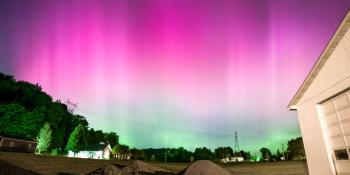Viendo archivo del miércoles, 9 marzo 2011
Informe actividad solar
Any mentioned solar flare in this report has a scaling factor applied by the Space Weather Prediction Center (SWPC). Because of the SWPC scaling factor, solar flares are reported as 42% smaller than for the science quality data. The scaling factor has been removed from our archived solar flare data to reflect the true physical units.
Informe de actividad Solar-Geofísica 2011 Mar 09 2200 UTCPreparado por NOAA © SWPC y procesado por SpaceWeatherLive.com
Informe conjunto USAF/NOAA de actividad Solar y Geofísica
SDF Número 068 Publicado el 2200Z a las 09 Mar 2011IA. Análisis de regiones solares activas y de actividad desde 08-2100Z hasta 09-2100Z Solar activity was moderate. Two M1 x-ray flares were
observed from Region 1166 (N09W12) which was an Ekc spot group with
a Beta-Gamma-Delta magnetic classification. The area of this region
and the number of spots increased over the last 24 hours. Region
1169 (N20E18) also grew in area and number of spots over the past 24
hours, ending the period as an Esc type spot group with a Beta-Gamma
magnetic classification. The remaining regions were either small
and magnetically simple (Region 1170) or decaying (Region 1164) and
rotating off the visible disk.
IB. Pronóstico de la actividad solar
Solar activity is expected to remain
moderate for day 1 (10 March) with a chance for M-class activity
from Region 1166 or Region 1169.
IIA. Resumen de la actividad geofísica 08-2100Z a 09-2100Z
The geomagnetic field was quiet. The greater than 10 MeV proton flux
remained above the 10 pfu threshold throughout the past 24 hours.
Solar wind speed measured at the STEREO-A spacecraft jumped from
approximately 650 km/s to 870 km/s near 09/0700Z. This jump was
accompanied by southward Bz to -20nT. These observations were
consistent with a shock passage from the CME that originated on
07/2012Z. The greater than 2 MeV electron flux at geosynchronous
orbit reached high levels during the period.
IIB. Pronóstico de la actividad geofísica
The geomagnetic field is
expected to be unsettled to active, with isolated minor storm
periods possible at high latitudes on day one (10 March), and
primarily unsettled conditions on days two and three (11-12 March).
The CME from 07 March is expected to arrive mid-day on 10 March,
leading to the elevated activity.
III. Probabilidades del evento 10 Mar a 12 Mar
| Clase M | 50% | 40% | 30% |
| Clase X | 05% | 05% | 01% |
| Protón | 75% | 50% | 20% |
| PCAF | yellow | ||
IV. Penticton 10.7cm flujo
Observado 09 Mar 143 Previsto 10 Mar-12 Mar 145/145/140 Media de 90 Días 09 Mar 092
V. Índices Geomagnéticos A
Observado Afr/Ap 08 Mar 004/005 Estimado Afr/Ap 09 Mar 005/008 Previsto Afr/Ap 10 Mar-12 Mar 020/022-012/018-008/008
VI. Probabilidades de Actividad Geomagnética 10 Mar a 12 Mar
| A. Latitudes Medias | |||
|---|---|---|---|
| Activo | 25% | 25% | 25% |
| Tormenta Menor | 20% | 15% | 01% |
| Tormenta Mayor-Severa | 10% | 05% | 01% |
| B. Latitudes Altas | |||
|---|---|---|---|
| Activo | 35% | 35% | 35% |
| Tormenta Menor | 25% | 20% | 05% |
| Tormenta Mayor-Severa | 15% | 10% | 05% |
All times in UTC
< < Ir a la visión general diaria
Últimas noticias
Últimos mensajes del foro
Red Auroras 17AR3664 1105A little bit about our hobby for the general public 7Is there any truth to this "Internet/Electrical Grid Apocalypse"? 174Unproven theories 482
Más temasApoye a SpaceWeatherLive.com!
Mucha gente viene a SpaceWeatherLive para seguir la actividad del Sol o previsión de aurora, pero con esta cantidad de tráfico se incrementan los costos del servidor. ¡Considere hacer una donación si disfruta de SpaceWeatherLive para que podamos mantener el sitio web en línea!

Hechos clima espacial
| Último evento clase X | 2024/05/15 | X2.9 |
| Último evento clase M | 2024/05/19 | M1.6 |
| Últimas tormentas geomagnéticas | 2024/05/17 | Kp6 (G2) |
| Días sin manchas | |
|---|---|
| Último día sin manchas | 2022/06/08 |
| Promedio de manchas solares mensuales | |
|---|---|
| abril 2024 | 136.5 +31.6 |
| mayo 2024 | 155.9 +19.4 |
| Last 30 days | 163.2 +40.8 |


